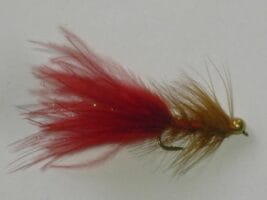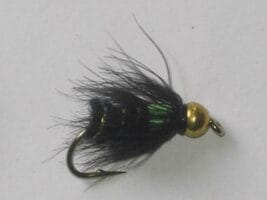Your cart is currently empty!
Description
The Tungsten Burning Fire Fly represents an innovative fusion of traditional nymph design with modern materials and striking coloration. This sophisticated pattern combines the superior sink rate of tungsten beads with a distinctive “burning fire” color scheme to create an exceptionally effective pattern for both moving and still waters.
Design Philosophy and Innovation?The pattern’s design reflects deep understanding of:
- Fast-sinking properties
- Light reflection
- Pattern visibility
- Movement dynamics
- Strike triggering
Premium Materials and Construction?Traditional Materials:
- Tungsten bead
- Premium hooks
- Selected dubbing
- Strong thread
- Fire-colored materials
Modern Adaptations:
- Enhanced sink rate
- Advanced techniques
- Specialized materials
- Strategic flash
- Movement enhancement
Technical Specifications
Hook Configuration:
- Style: Nymph/Jig
- Sizes: 12-18
- Strength: Strong
- Finish: Black nickel
- Point: Chemically sharpened
Body Construction:
- Thread: Fire orange
- Body: Burning fire dubbing blend
- Ribbing: Fine wire
- Thorax: Enhanced dubbing
- Hot spot: Fluorescent
Water Type Applications
River Tactics:
- Fast runs
- Deep pools
- Pocket water
- Seams
- Structure areas
Stillwater Approaches:
- Drop-offs
- Weed beds
- Deep channels
- Shelves
- Various depths
Seasonal Effectiveness
Spring:
- Early season
- High water
- Cold conditions
- Variable depths
- Multiple presentations
Summer:
- Peak season
- Morning/evening fishing
- Bright conditions
- Technical fishing
- Deep running
Fall:
- Late season
- Changed water
- Selective fish
- Multiple depths
- Various speeds
Winter:
- Deep pools
- Slow presentations
- Limited feeding
- Precise placement
- Temperature considerations
Advanced Fishing Methods
River Techniques:
- Euro Nymphing
- Short-line control
- Contact nymphing
- Tight-line methods
- Indicator options
- Direct connection
- Traditional Nymphing
- Indicator fishing
- Dead drift
- Swing and lift
- Multiple depths
- Pattern combinations
Stillwater Approaches:
- Static Fishing
- Slow retrieve
- Hang technique
- Figure-8 retrieve
- Variable depths
- Pattern control
- Dynamic Presentations
- Pull and pause
- Strip retrieve
- Varied speeds
- Depth changes
- Multiple methods
Water Reading and Strategy
Key Factors:
- Current speed
- Water clarity
- Structure location
- Temperature
- Light conditions
Strategic Approaches:
- Depth selection
- Pattern choice
- Presentation angle
- Retrieve speed
- Line control
Environmental Adaptations
Light Conditions:
- Bright sunshine
- Overcast days
- Early morning
- Evening light
- Low light effectiveness
Water Clarity:
- Crystal clear
- Slightly colored
- Stained water
- Post-rain
- Variable visibility
Pattern Benefits
Design Advantages:
- Fast sinking
- Strong profile
- Better visibility
- Strike triggering
- Modern effectiveness
Performance Benefits:
- Consistent results
- Natural movement
- Fish attraction
- Energy efficiency
- Versatile fishing
Advanced Applications
Specialized Techniques:
- Deep nymphing
- Structure fishing
- Current seams
- Technical water
- Multiple depths
Tactical Adaptations:
- Weather conditions
- Water levels
- Fish behavior
- Seasonal changes
- Time of day
Advanced Rigging
Leader Setup:
- Length selection
- Tippet material
- Breaking strength
- Knot choice
- System balance
Equipment Matching:
- Rod weight (3-6wt)
- Line type
- Leader design
- Tippet selection
- Terminal tackle
Pattern Variations
Size Adaptations:
- Standard sizes
- Scaled versions
- Custom ties
- Situation-specific
- Water-matched
Color Variations:
- Traditional fire
- Enhanced hot spot
- Subdued versions
- Light conditions
- Water clarity
Advanced Color Combinations:
- Fire orange/black contrast
- Red/copper blends
- Gold/orange variations
- Purple/fire highlights
- UV-enhanced versions
Regional Adaptations:
- Mountain stream versions
- Tailwater variations
- Stillwater modifications
- Spring creek patterns
- Lake-specific ties
Technical Considerations
Tungsten Properties:
- Superior density
- Fast sinking
- Weight control
- Pattern balance
- Depth achievement
Color Enhancement:
- UV reflection
- Light penetration
- Visibility factors
- Attraction properties
- Strike triggering
Advanced Presentation Methods
River Specifics:
- Seam fishing
- Pocket water
- Deep runs
- Structure approach
- Current breaks
Stillwater Techniques:
- Drop-off fishing
- Weed edge work
- Deep channels
- Shelf fishing
- Basin approaches
Seasonal Applications
Spring Tactics:
- High water techniques
- Cold water methods
- Early season approaches
- Fish behavior patterns
- Energy conservation
Summer Strategies:
- Peak season presentations
- Light penetration factors
- Temperature considerations
- Feeding patterns
- Time of day
Fall Methods:
- Changed water tactics
- Temperature changes
- Migration patterns
- Aggressive triggers
- Weather influences
Winter Approaches:
- Deep water techniques
- Slow presentations
- Limited feeding
- Temperature factors
- Pattern size
The Tungsten Burning Fire Fly represents the perfect fusion of traditional design and modern innovation. Its sophisticated engineering incorporates fast-sinking properties with striking visibility, creating a pattern that consistently produces results in both rivers and stillwaters. Whether targeting trout in deep runs or working stillwater drop-offs, this pattern delivers exceptional performance through its carefully calculated design elements and versatile presentation capabilities.
Additional information
| Hook type | Barbed Hooks, Barbless Hooks |
|---|---|
| Hook size | 10, 12, 14, 16, 18, 20 |







